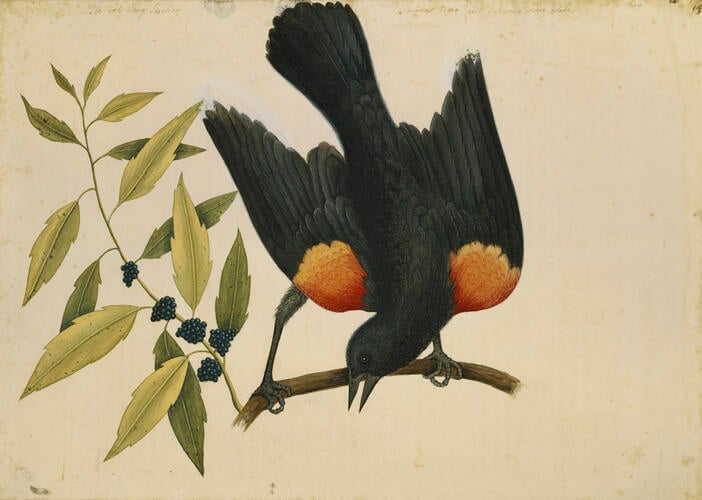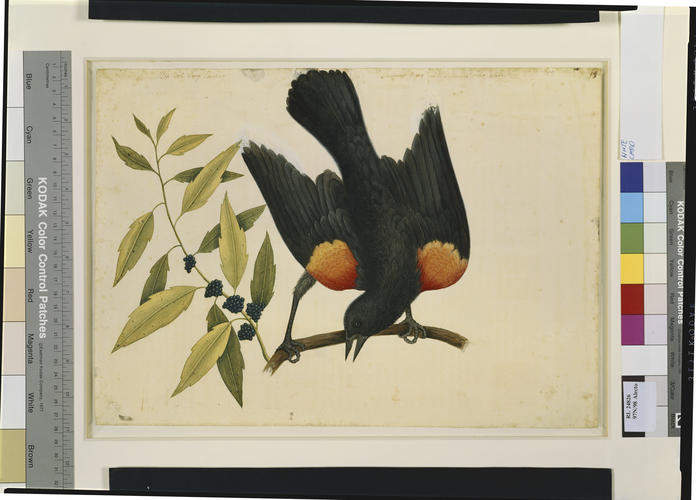-
1 of 253523 objects
The Red wing'd Starling and the Broad-leaved Candle-berry Myrtle 1722-26
Pen and ink with watercolour and bodycolour, white heightening used to erase areas of the wings and tail | 26.2 x 37.4 cm (sheet of paper) | RCIN 924826
-
A watercolour of a red-winged blackbird (Agelaius phoeniceus (Linnaeus)) on a branch of southern bayberry (Morella caroliniensis (Mill.)). The drawing shows a dark bird, perched facing front, looking down with beak open. The tops of its wings are a deep golden orange, the plant has bright green leaves and clusters of small black berries. Inscribed in ink: (top centre) 'The red wing Starling' and 'Sturnus Niger alis Supernis rubro colore'; (top right) '14' corrected to '13'.
The paper bears half of a watermark of a shield with a fleur-de-lys (Type A in Henrietta McBurney, Illuminating Natural History. The Art and Science of Mark Catesby, New Haven and London, 2021, p. 225-6).
Mark Catesby was born in Suffolk and was interested in natural history from an early age. In 1712, he travelled to the east coast of America with his sister Elizabeth, who had married a doctor who practised in Williamsburg, Virginia. Catesby spent seven years in Virginia collecting specimens and seeds for London buyers before returning to Britain. In London his drawings of birds and plants met with praise and a group of benefactors paid for his travel to Carolina in 1722. There, he made numerous drawings of the flora and fauna, working hard to ensure that his depictions were as helpful for an understanding of their subjects as possible. On his return to Britain, his drawings were reproduced in The Natural History of Carolina, Florida and the Bahama Islands, which appeared in a series of volumes between 1729 and 1747. The first volume was dedicated to Queen Caroline, the second to Augusta, Princess of Wales. The original drawings from the volumes, which had been in the possession of Catesby’s widow until her death, were purchased by George III from the London bookseller Thomas Cadell in 1768.
This watercolour was used as the basis for plate 13 in the first volume of the Natural History ('The red wing'd Starling' and 'The broad-leaved Candle-berry Myrtle'). In the accompanying text, Catesby noted that this blackbird was often found with the grackle illustrated on the previous plate (plate 12, and RCIN 924825): 'They seem combined to do all the mischief they are able: and to make themselves most formidable, both kinds unite in one flock, and are always together, except in breeding-time; committing their devastations all over the Country.'
Henrietta McBurney has shown how the pose of the bird in this watercolour is copied from a print illustrating Aesop's Fables by Francis Barlow (Henrietta McBurney, Illuminating Natural History. The Art and Science of Mark Catesby, New Haven and London, 2021, pp. 132-3).For identification of the species depicted see James L. Reveal, ‘Identification of the plants and animals illustrated by Mark Catesby for his Natural History of Carolina, Florida, and the Bahama Islands’ in Phytoneuron 2013 and revised online version.
Provenance
Thomas Cadell; from whom bought by George III, 1768
-
Creator(s)
Acquirer(s)
-
Medium and techniques
Pen and ink with watercolour and bodycolour, white heightening used to erase areas of the wings and tail
Measurements
26.2 x 37.4 cm (sheet of paper)
Other number(s)
RL 24826Alternative title(s)
Sturnus niger alis superne rubentibus; Myrtus Brabanticae similis; Caroliniensis, humilior; foliis latioribus & magis serratis

